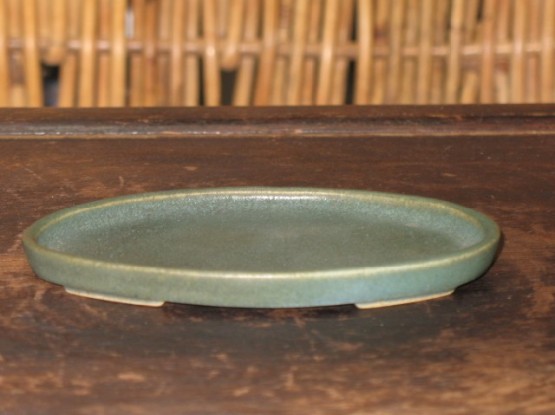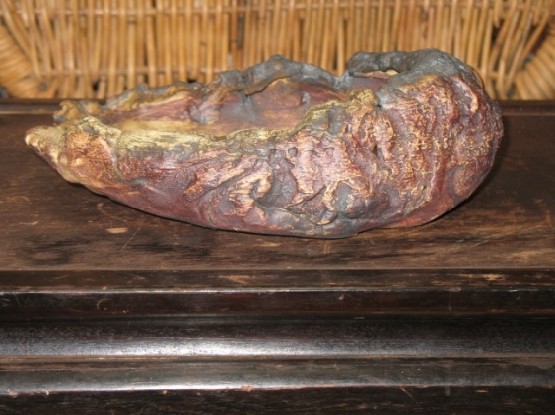At the February 20, 2007, meeting of the Iowa Bonsai Association, bonsai pots and their sources were discussed, with a number of examples brought by club members. Obviously, there are a number of sources for pots and a great variety of pot styles to utilize in creating a bonsai’s effect. The following notes refer to only a portion of the pots discussed but do provide some leads on pot makers and bonsai pot information.
BONSAI POTS
At mid-day on 2/20/07 on the internet:
- Bonsai pot as search word on Google: 1,100,000 listings
- Bonsai pots as search word on Google: 1,140,000 listings
- Bonsai pot as search word on eBay: 446 listings
- Bonsai pots as search word on eBay: 473 listings
- Obviously there are a lot of sources for bonsai pots.
The pot is ½ of the bonsai, as bonsai is defined as a tree in a pot. It is just as important as the tree in making the final composition. It can not dominate the tree; the two must act together to make an integrated visual statement. Therefore, the pot should not initially be noticed as a separate entity.
Examples:
Asian

Chinese glazed round. Mid-20th century, South China Used in a personal bonsai collection in Java for 50 years. Typical of historical Chinese pots.

Chinese green purple clay round pot with peg legs Contemporary Yixing China. Typical of much modern Chinese pot production.

Chinese round lotus pot. Ca. 1990s Typical of better Chinese pots in the bonsai trade for the last two decades.

Japanese oval kusamono pot. Ca. 2004 Hand-finished molded pot, Tokoname. Chop mark on base. High quality Japanese pot, typical of what is used for good shows.

Japanese round Bizen pot. Ca. 1965 Bizen is one of the six ancient kilns of Japan. Great gravitas. Very, very wabi sabi. Most desirable for serious tea ceremony vessels. Not often encountered as a bonsai pot except for accompanying plants.
American

*Jack Bacus, textile bag design accompanying plant pot. 2006. East Alton, Illinois. Began in bonsai in 1980 and then studied ceramics so as to be able to make his own bonsai pots. Strives to make unique designs; calls them Jackpots.

*Dave Lowman, accompanying plant pot. 2006 Dasu Studio Bonsai Pottery, Kelley, Iowa. Started sculpting plasticine clay at the age of 5. Best known for his special process finish and fossil finish pots.


*Jim Barrett, two contemporary pots: mame cascade pot, and mame suiban Arcadia, California. Well known American bonsai potter. Very distinctive cascade style pots. Began making bonsai pots in 1975.

*Sara Rayner, round pot. 2006. Typical of her current style Redwing, Minnesota. A production potter who has made only bonsai pots since 1993. Very popular among American bonsai enthusiasts. Well known since winning an award in the first bonsai pot competition sponsored by the National Bonsai & Penjing Museum.

Gary Wood, round flat pot. Ca. 2002. Muscle Shoals, Alabama. Bonsai guru, nurseryman, bonsai potter, and philosopher, Gary makes bonsai pots which are almost all sold pre-order wholesale to bonsai businesses. Occasionally he will sell some of his pots to friends and to workshop participants.
European

*Bryan Albright, round unglazed pot. 2006 Norwich, United Kingdom. Started making bonsai pots for sale in 1985. Best known for his glazed pots but he considers his nanban and unglazed pots to be the most challenging and interesting. A significant bonsai potter on the European scene.

*John Pitt, Accompanying plant pot. 2006 Derbyshire, United Kingdom. Has been making frost proof bonsai pots since 1998. Typical of where the bonsai business has been moving the last few years, most of his sales are world-wide via the internet.

*Mario Remeggio, round nanban. 2002? Certre, Villorba, Italy. The pots form this kiln are considered by many to be the best bonsai pots made in Europe.

*Victor and Glyn Harris, non-traditional flat pot. 2006 Erin Pottery, Bristol, United Kingdom. This father-son team began bonsai in the 1980s and was rapidly disappointed by the available bonsai pots. Deciding to make pots worthy of a bonsai tree, their pots were soon noticed. They founded Erin Pottery in 1994. Another example of a successful bonsai potter selling on the internet.
*Potters who are noted in the book listed below, a current authoritative book on bonsai pottery.
Bonsai Potters, by Daan Giphart and Levon Arzooyan. N.l.: n.p., 2006. Limited print paperback. Available from Stone Lantern (www.stonelantern.com) for $35. A compilation of information on 59 of the best contemporary Western bonsai potters.


